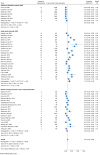Prevalence and Risk Factors for Postoperative Neurological Complications in Spinal Deformity Surgery: A Systematic Review and Proportional Meta-Analysis
- PMID: 40211531
- PMCID: PMC12010854
- DOI: 10.14245/ns.2449364.682
Prevalence and Risk Factors for Postoperative Neurological Complications in Spinal Deformity Surgery: A Systematic Review and Proportional Meta-Analysis
Abstract
Objective: To investigate the incidence of postoperative neurological complications among patients who underwent spinal deformity surgery and to determine the significant risk factors for postoperative neurological complications.
Methods: Six databases PubMed, Web of Science, Scopus, MEDLINE, Embase, and Cochrane Library have been searched to identify observational studies from inception until January 2025. Inclusion criteria were patients aged ≥10 years with postoperative neurological complications after spinal deformity surgery. Stata/MP18.0 was used to conduct the meta-analysis in this review. The summary incidence estimates, proportion with 95% confidence intervals (CIs) and weights were pooled by the random-effects restricted maximum likelihood model.
Results: The search strategy identified 53 articles with 40,958 patients for final review. Overall incidence of postoperative neurological complications was 7% (95% CI, 5.0%-9.0%; p < 0.001; I2 = 98.34%) in which incidence estimates for patients with adult spinal deformity and underwent 3-column spinal osteotomies were 12% (95% CI, 9%-16%; p < 0.001; I2 = 93.17%) and 18% (95% CI, 8%-31%; p < 0.001; I2 = 94.68%) respectively. Preoperative neurological deficit was the risk factor with highest overall odds ratio (OR, 2.86; 95% CI, 1.85-4.41; p = 0.01; I2 = 76.20%), followed by the presence of kyphosis (OR, 1.13; 95% CI, 0.75-1.70; p = 0.02; I2 = 81.80%) and age at surgery (OR, 1.04; 95% CI, 1.01-1.08; p = 0.04; I2 = 68.80%).
Conclusion: Preoperative neurological deficit, the presence of kyphosis and age at surgery were significant risk factors for postoperative neurological complications. Therefore, comprehensive preoperative assessment and surgical planning are crucial to minimize the risk of developing postoperative neurological complications or the deterioration of pre-existing neurologic deficits.
Keywords: Neurological complications; Postoperative complications; Spinal deformity; Spinal deformity surgery.
Conflict of interest statement
The authors have nothing to disclose.
Figures



Similar articles
-
Association between deformity angular distance ratio and neurological risk in patients undergoing three-column osteotomy.J Neurosurg Spine. 2025 Feb 7;42(4):470-480. doi: 10.3171/2025.1.SPINE241396. Print 2025 Apr 1. J Neurosurg Spine. 2025. PMID: 39919280
-
Risk factors for neurological complications in severe and rigid spinal deformity correction of 177 cases.BMC Neurol. 2020 Nov 28;20(1):433. doi: 10.1186/s12883-020-02012-8. BMC Neurol. 2020. PMID: 33246421 Free PMC article.
-
Association of preoperative hypoprotein malnutrition with spinal postoperative complications and other conditions: A systematic review and meta-analysis.Clin Nutr ESPEN. 2023 Oct;57:448-458. doi: 10.1016/j.clnesp.2023.07.083. Epub 2023 Jul 27. Clin Nutr ESPEN. 2023. PMID: 37739691
-
Incidence and Risk Factors for Major Surgical Complications in Patients With Complex Spinal Deformity: A Report From an SRS GOP Site.Spine Deform. 2015 Jan;3(1):57-64. doi: 10.1016/j.jspd.2014.06.008. Epub 2014 Dec 18. Spine Deform. 2015. PMID: 27927453
-
Two- versus multi-rod constructs for adult spinal deformity: A systematic review and Random-effects and Bayesian meta-analysis.J Clin Neurosci. 2023 Jan;107:9-15. doi: 10.1016/j.jocn.2022.11.011. Epub 2022 Nov 29. J Clin Neurosci. 2023. PMID: 36459919
References
-
- Romero-Muñoz LM, Segura-Fragoso A, Talavera-Díaz F, et al. Neurological injury as a complication of spinal surgery: incidence, risk factors, and prognosis. Spinal Cord. 2020;58:318–23. - PubMed
Grants and funding
LinkOut - more resources
Full Text Sources

